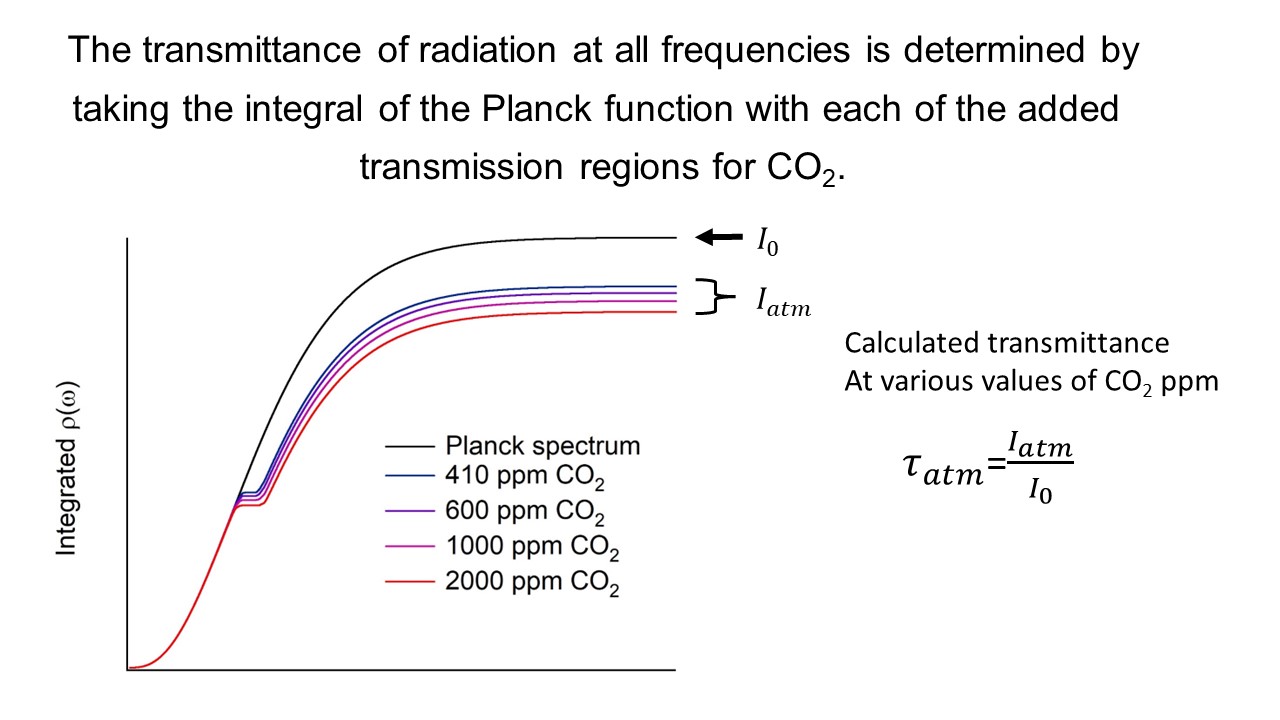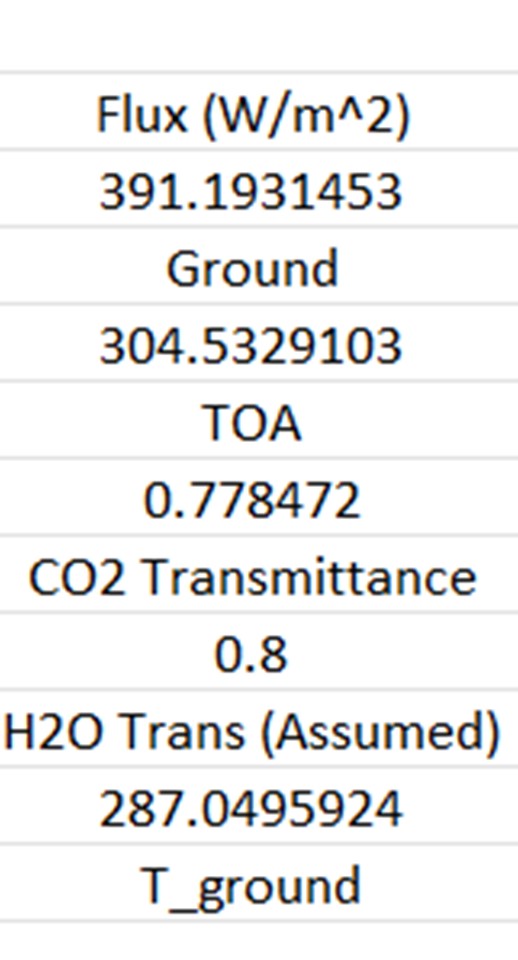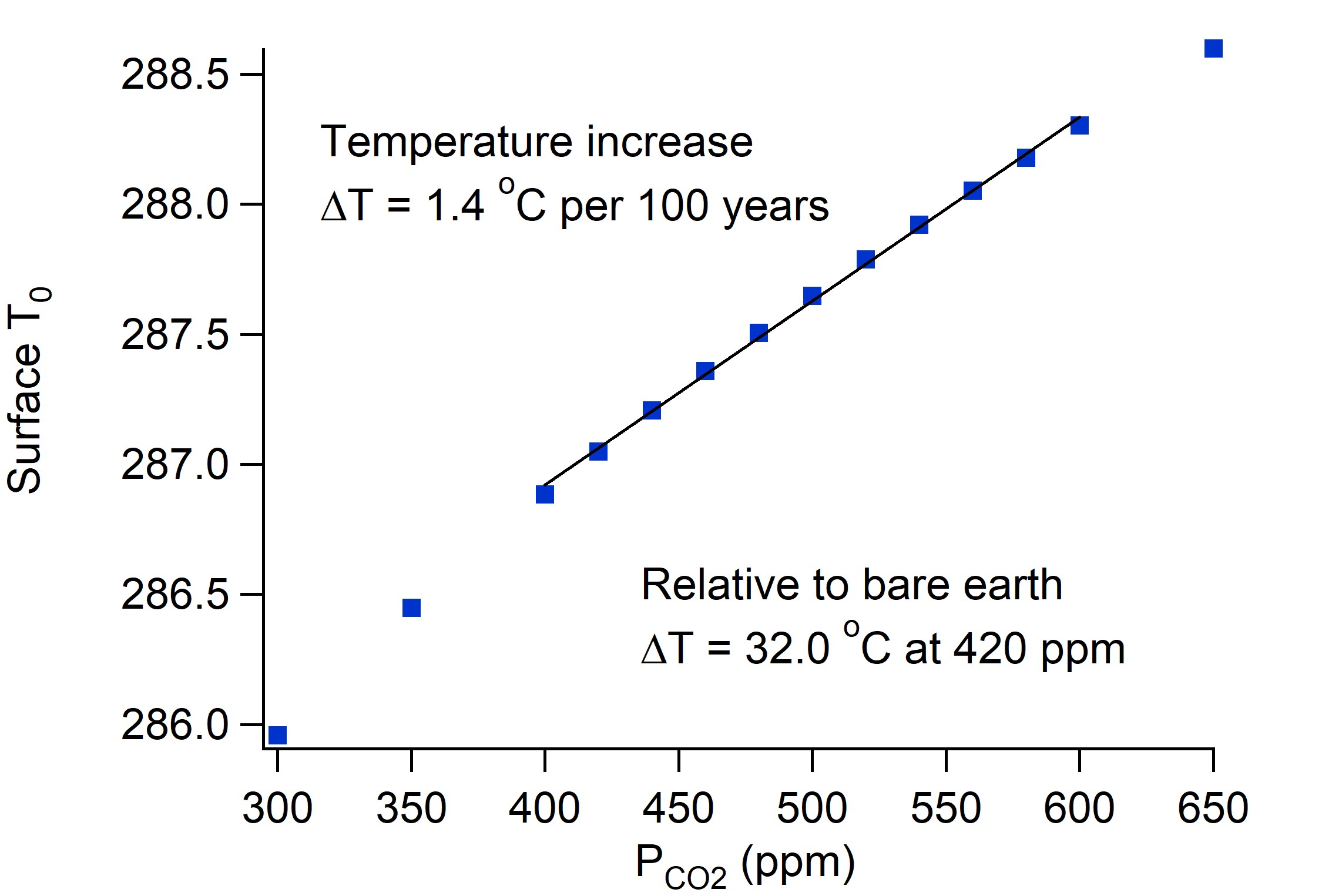Physical demonstration that atmospheric CO2 absorption warms the Earths' surface
Overview of Physical Proof
Overview of Applications
Each column of the Excel spreadsheet has a programmed function that is automatically executed
if any change is made elsehwere in the spreadsheet. These are described in the manuscript and Supporting Information.
The common changes are to introduce a new spectral data file in columns A and B or a new CO2 ppm value in column D.
Igor Spreadsheet Applications using <HITRAN data> for Visualization
Igor functions are available to implement the calculation of new values of transmittance
and temperature.
These macros (functions) are already available in the Earth_Temperature.pxp Igor file.
Each function accepts the CO2 partial pressure as an input. For example,
Calculate_Temperature(0.00042) on the command line executes all columns of the spreadsheet
including all graphs appropriate to atmospheric concentration of 420 ppm CO2.
The tools on this page using Excel, Igor Pro, and Python permit an observer to see the demonstration step by step.
QED: Calculation of Temperature vs CO2 ppm
Obtaining HITRAN data
In the example we have used, we select CO2 gas, na for natural abundance between 200 cm-1 and 2400 cm-1
This corresonds to 67091 transitions, which are not evenly spaced. The fortran program hgc.f [HITRAN Gaussian conversion]
creates a spectral data file of even spaced points with a separation of 0.01 cm-1
The program requests an input file in comma separated files, which is the default output from HITRAN.
This corresonds to 67091 transitions, which are not even spaced. The fortran program hgc.f [HITRAN Gaussian conversion]
creates a spectral data file of even spaced points with a separation of 0.01 cm-1
The program requests an input file in comma separated files, which is the default output from HITRAN.
Program requires input of the Doppler linewidth, which we have taken to be 0.13 cm-1.
The code can be compiled using the command line $ gfortran hgc.f -o hgc
The user may include isotopologues or even a superposition of methane and CO2
Ozone, nitrous oxide, and other gases can also be included as desired. These are simply
added to the list of HITRAN transitions provided as input to the hgc fortran program.
H2O could be added, but water enters the problem as a feedback that fluctuates rapidly.
For this reason we have followed other researchers who treat water as a global average.
The output file from this program can be used to replace the first two columns of either the Excel
or Igor spreadsheets, which will automatically calculate absorbance, transmittance,
the Planck function at 288 K and the product of Planck function and transmittance.
The integral of these last two quantities is used to calculate the global transmittance.
Column A consists wavenumber values (cm-1).
There are 240,000 wavenumber values from 0.01 to 2,400 used as the independent variable for all other columns.
Column B (plotted vs A) is the CO2 bending mode spectrum based on HITRAN.
This output is plotted in:
Column C
The constants Patm/MCO2g at 1 atm of pressure are multiplied by CO2 mole fraction in columnd D.
Column D
The mole fraction of xCO2. Enter a new value here to calculate new transmittance.
The transmittance multiplied by the Planck emission is used to calculate the Earth's surface temperature.
Column E
This column is the cross-section number density in one square meter above the Earth's surface.
This is the product of the previous two columns C and D, uTOA=Patm/MCO2g.
Column F
F is the effective absorbance of CO2 per square meter.
F (= B * C * D) or F = B * E.
Column G
G is the simple transmittance G = 10-F. It is the fraction of radiation that passes through the atmosphere at a given wavenumber.
Column H
H is a correction to the transmittance based on numerical integration.
It converts the spectral point source into a radiation flux per square meter.
H = (10-1.245F + 10-0.13F)/2
Column I
I is the corrected transmittance converted from absorbance in column B and the cross-sectional number density in E.
It also converts the spectral point source into a flux.
I = (10-2.245BE + 10-1.13BE)/2
The output is plotted in column I of the Excel spreadsheet:
Column J
J is the temperature in the calculated Planck distribution. The default used is 288 K.
Column K
K is the Planck distribution at temperature J. Visualize it in a plot of column K.
Column L
Column L is the Planck distribution times the transmittance in column I.
Both K and L are plotted for comparison in
Visualizing integration
We can visualize the steps of integration of the Planck distribution with and without CO2 transmission.
The global transmittance, tau_atm is the ratio of the integral (shown here as the sum) at each value of CO2 to I0 the intensity of radiation emitted by the bare earth.

Each of these curves is the summation of Planck radiation with no CO2 or varying ppm.
Column M Temperature and Transmittance vs. CO2 ppm
The M column contains a global average transmittance of CO2 and the temperature at the Earth's surface.

By calculating a number of different temperatures, transmittances, and CO2 ppm
we can visualize the temperature effect at the Earth's surface as CO2 increases.

Python code for visualization
Each of the python scripts is a standalone application.. They carry out all the operations of the Excel spreadsheet.
.
Converting HITRAN data to a Gaussian or Lorentzian broaded extensive spectrum.
<hitran_to_gaussian.py >
<hitran_to_lorentzian.py >
Column B: The HITRAN spectrum of CO2 calculated using line broadening.
<transmittance_co2_ppm.py >
Column I: The transmittance of CO2
<transmittance_co2_ppm.py >
Columns K and L: Planck distribution (K) and product with The transmittance of CO2 (L)
< planck_transmittance_compare.py >
Integrated Planck curve and Planck times CO2 curve.
< planck_transmittance_int_compare.py >
The transmission and temperature as a function of CO2 ppm are given by:
< plot_co2_ppm_vs_temp.py>
The script will read the ppm values in co2_ppm_full.txt and use the transmittance at a given value of CO2 ppm to calculate the temperature.
Single point calculation of temperature as a function of CO2 ppm is given in:
< plot_co2_ppm_vs_temp.py>
Caveat: the Python code can process at least 24,000 data points. The result obtained is qualitatively similar, but slightly smaller. This is due to a resolution effect since the Python integration has steps of 0.1 cm-1, while Excell can handle 0.01 cm-1. We welcome any improvements.
Data input files
<co2_ppm_full.csv>: column of ppm values from 300 to 1000 → needed for <plot_co2_ppm_vs_temp.py>
<co2_ppm.csv>: two ppm values 410 and 1000 needed for <planck_transmittance_compare.py> and <planck_transmittance_int_compare.py>
<co2_bending.csv>: HITRAN data for CO2 bending needed for all scripts<co2_bending_stretch.csv>: HITRAN data for CO2 bending and stretching needed for all scripts using the complete set of vibrationsl for CO2
<hitran.csv>: HITRAN data for CO2 bending and stretching used in hitran_to_gaussian to convert to the peaks with a Gaussian width of 0.13 cm\-1\ with a spacting of the wavenumber of only 0.01 cm-1. This file contains the 67,000 lines of CO2 bending and stretching vibrations. The python script rewrites those peaks preserving their intensity but broadening them and plotting them on a uniform spectroscopy base of 0.01 cm-1 in Excel. At present the python scripts run at 0.1-1, which means that only 24,000 data points are used to integration. This apparently reduces the accuracy of the result, but the ease of use suggests that python may be developed to help design the educational message.


